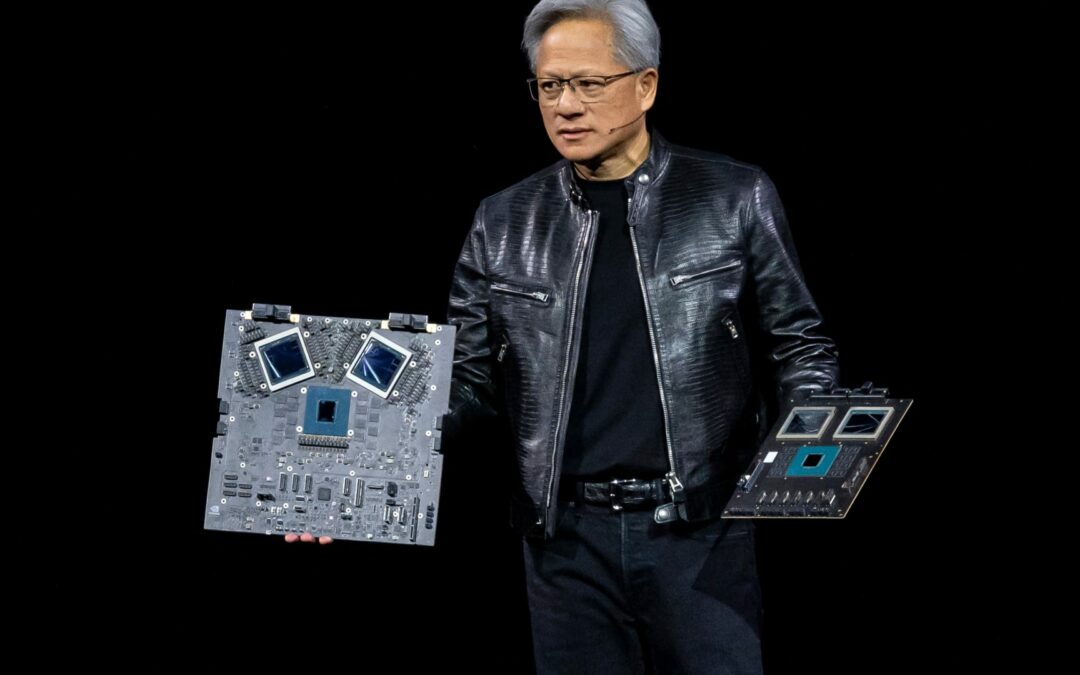Jensen Huang, co-founder and chief executive officer of Nvidia Corp., displays the new Blackwell GPU chip during the Nvidia GPU Technology Conference on March 18, 2024.
David Paul Morris/Bloomberg via Getty Images
Not all chip firms are benefiting from the boom in artificial intelligence, earnings show, underscoring the complexities of the semiconductor supply chain and dominance of some companies over others in different parts of the sector.
A slew of semiconductor companies have reported financial results for the June quarter, with some smashing expectations and others disappointing, providing a glimpse into how excitement over AI is affecting their earnings.
Current interest in artificial intelligence revolves around two key terms — large language models (LLMs) and generative AI. LLMs require huge amounts of computing resources and data to train and they underpin generative AI applications like chatbots from Google and OpenAI.
Tech giants training the LLMs are not cutting back on spending. Meta said on Wednesday it expects “significant” growth in capital expenditure in 2025 “to support our AI research and our product development efforts.” Microsoft said this week its capital expenditure rose nearly 80% year-on-year to $19 billion in the June quarter.
This spending by tech giants, as they continue to add computing resources, has been a huge boost for Nvidia because the company’s graphics processing units (GPUs) are used to train these LLMs.
But Nvidia’s rival AMD has brought its own chip to market, called the MI300X AI chip, for AI purposes and is beginning to see the rewards. AMD said on Tuesday that it expects data center GPU revenue to exceed $4.5 billion in 2024, up from the $4 billion the company forecast in April. The chip company reported earnings and revenue for the second quarter that beat market expectations.
Chip manufacturing and tool companies appear to be benefiting too from the boom in AI. TSMC, the world’s largest maker of semiconductors, said last month that its second-quarter net profit rose more than 36% year-on-year as its financial results beat market expectations.
Meanwhile ASML, which produces specialist tools required to manufacture the most advanced chips in the world, said last month that net bookings in the second-quarter jumped 24% year-on-year, highlighting demand from companies like TSMC who make the semiconductors. Samsung said second-quarter operating profit soared 1,458.2% year-on-year.
But not all semiconductor firms have been lifted by the growth of AI investment because their exposure to the technology is currently much less significant at this stage of its development.
Qualcomm and Arm saw their share price fall on Wednesday after issuing light guidance for the current quarter.
While both of these companies have been talking up their importance to AI applications, the reality is their exposure to the technology is still very limited.
Arm designs the blueprints that many companies base their chips on, and Arm’s semiconductors are in most of the world’s smartphones. While many electronic makers are talking about AI phones, this has not led to fundamentally higher growth for the chip designer.
The British firm still gets a large chunk of its revenue from consumer electronics rather than data centers where AMD and Nvidia have found success. Analysts have previously told CNBC Arm could benefit from AI when more devices begin to incorporate the technology.
Qualcomm’s chips feature in smartphones such as those produced by Samsung, and the company still makes a lot of its revenue from handsets. Similar to Arm, Qualcomm’s silicon is not used in the type of data centers where the training of LLMs is taking place.
The company’s chips will be in Microsoft’s upcoming AI PCs, but again, this is a longer-term play for Qualcomm.








